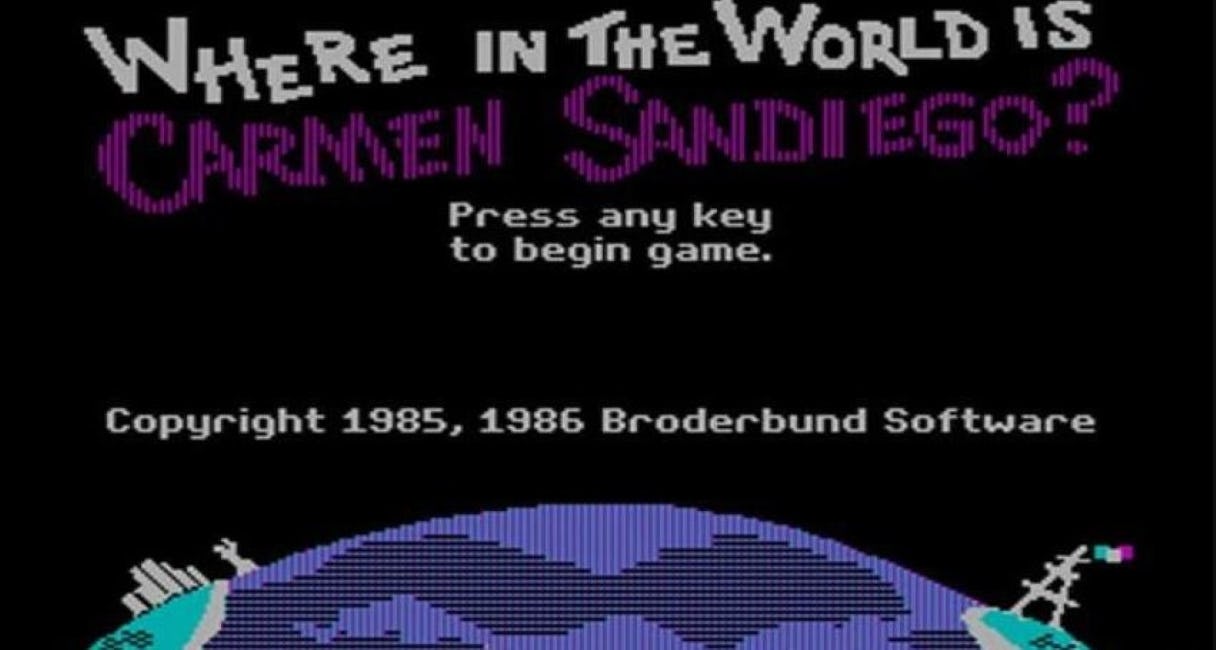
Learning is a chore. Literally, it’s the first thing many of us encounter that we are told we have to do in spite of the fact we don’t want to. We know it's important for us to learn about things like math, history, or science. That doesn’t always mean it's fun, especially for kids. For children of the ‘90s, video games were the reward after a long day of learning. Educational games did exist but most were so god awful they never graced store shelves. So it was a revelation 40 years ago when an educational video game – bundled with a book! – became a bona fide phenomenon and one of the most beloved games of a generation.
Where in the World is Carmen Sandiego? launched for PC on April 23, 1985. The central premise was simple. Track down the elusive thief Carmen Sandiego by apprehending different members of her gang who have a predilection for stealing famous artifacts and, somehow, even landmarks. Players would be given clues that came straight out of social studies class. They weren’t always obvious and would sometimes require the use of an accompanying World Almanac, a genuine school book you’d normally never associate with something as cool as video games. Yet 40 years, 17 games and four TV series later, the legacy of the greatest educational game of all-time lives on.
At the time of its debut, PC games were a far cry from the specs-driven eye candy we know today. Most games were text-based and, in fact, Where in the World is Carmen Sandiego? was one of the very first to include graphics. They were rudimentary postcards of different global landmarks, but were still breakthrough nonetheless and a key component for what kept kids playing the game. It looked interesting.
At its core, Where in the World is Carmen Sandiego? was a geography game. Players took on the role of a rookie detective working for the ACME Detective Agency, chasing Carmen and her colorful cast of V.I.L.E. (Villain’s International League of Evil) henchmen across continents. Each new clue dropped tidbits of geographical, cultural, or historical significance. Kids might start by following a suspect to Egypt because they mentioned the Nile, then head to Brazil after hearing about samba music. The mechanics were simple, but the real magic came from how seamlessly the game blended gameplay with learning.
In the pre-Google era, the game’s reliance on the included World Almanac was both brilliant and frustrating. Players had to physically reference the book to decode clues, encouraging real research skills and reading comprehension. It was homework without feeling like homework. And that was its genius. The game didn’t talk down to its audience. It expected you to think. It demanded you learn, and it rewarded that learning with the thrill of the chase.

By the early 1990s, the franchise had grown beyond PC to include platforms like Sega Genesis and Super Nintendo. It went beyond games, too. The PBS game show, Where in the World is Carmen Sandiego?, debuted in 1991 and became an after-school staple. Hosted by Greg Lee and featuring the unforgettable a cappella group Rockapella, the show brought the energy of the game to television. Kids competed to track down Carmen through real-life geography challenges, and it didn’t hurt to have one of the catchiest theme songs in television history, either. The show didn’t just entertain; it created a shared cultural experience. Kids who might have struggled with geography in school suddenly had a reason to care about Botswana or Kathmandu.
The game’s impact extended into the broader culture. At a time when every single video game character seemed to be a white dude, Carmen Sandiego became a beloved anti-hero of sorts. It was rare to see a Latina woman in children’s media. The legendary actress Rita Moreno even voiced her in the popular Saturday morning TV series on Fox. She wasn’t some caricature, either. Carmen Sandiego was always portrayed as brilliant, cunning, and non-violent. You didn’t out-fight Carmen Sandiego, you had to outsmart her.

Where in the World is Carmen Sandiego? stands as a rare example of truly successful edutainment. Too often, educational games feel more like lectures with a few buttons tacked on. But Carmen taught us that with the right framing, learning could be an adventure in its own right.
It proved that kids were more sophisticated than the toy and game companies gave them credit for, and that they could handle complex information when it was delivered alongside good game mechanics and thoughtful design. In a world where children's attention is now split across TikToks, YouTube shorts, and a thousand app-based games, it’s worth remembering these lessons. Education can still be an adventure. All it takes is a good mystery, a passport full of clues, and a criminal mastermind in the baddest trench coat and hat combo you’ve ever seen.







